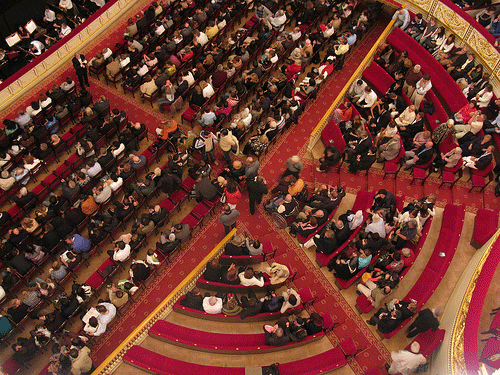In part 1 of this 3-part entry, I left you with the burning question: What are arts groups doing to build audience diversity through social networking? I decided to ask arts organizations around the country two questions that are relevant to any arts organization with a social networking strategy (and not just during Black History Month):
- How is your org are selecting which social networking sites are worthwhile?
- Are you taking diversity into account when forming these strategies?
 "St Petersburg - Alexandrinsky Theater" by thisisbossi / CC BY-SA 2.0
"St Petersburg - Alexandrinsky Theater" by thisisbossi / CC BY-SA 2.0
This can be a very sensitive issue and I am very grateful to the orgs that chose to take on this question. I contacted organizations of different sizes and different artistic disciplines. The answers I got were very in line with conventional wisdom of creating and streamlining a social media presence. Brian Hinrichs of Madison Opera says that he tries to focus on the two websites with both the most users and the most relevant users to his organization, Facebook and Twitter.
Facebook has the most users. We do have a MySpace page, which I understand has a more diverse user base, but that was not intentional. MySpace proved to have a large singer community, but I was not finding Madison Opera fans… Most of our MySpace friends, which is very few, also have Facebook accounts. Anecdotally, I find that to be the case in Madison and so for convenience of updating I am focusing most of my efforts to Facebook.
Thomas Cott of Alvin Ailey American Dance Theater (and the daily arts newsletter You’ve Cott Mail) also advocates focusing on a few sites rather than less coverage on more networks. Ailey boasts the largest Facebook Fan base of any nonprofit arts organization, at over 32,000, and is planning on rolling out pages for other programs like Ailey II and the Ailey School.
Ailey has focused its attention primarily on Facebook and YouTube (we’re phasing out our MySpace presence), because we feel it’s too hard to be everywhere at once… Of course, maintaining a robust presence on a social media site like Facebook requires a lot of staff time, and even for a big company like Ailey, we don’t have an endless reservoir of staff time to devote to this. That’s the main reason why we haven’t pursued Twitter or some of the newer outlets like Foursquare. It’s also why we haven’t put our attention to more ‘niche’ websites like blackplanet.com. We feel we are reaching a diverse audience on Facebook and YouTube, and since they are the biggest sites out there right now, we felt that was the best place for us to devote our attention.
Paul Montenegro maintains the social networking sites of GALA Hispanic Theatre in Washington D.C. He chooses to focus on Facebook and Twitter said that he focuses on the website’s functionality in his choice of networks.
I personally find the sites to be more user friendly when it comes to making events or sharing information. If there are sites out there are can do a better job or similar one, I would be looking into it to ensure that we can contact patrons via the web.
I contacted several other arts organizations who, like GALA, had mission statements which specifically focused on sharing the artist achievements or preserving the heritage of one ethnic or cultural group. I had hoped that they might be able to tell me how they decided which social networks to create a presence on, but they declined to comment. However, groups who did not have a mission statement that focused on one culture or missions to serve the community-at-large, were willing to talk about their choice of social media sites in the context of diversity.
Like many of these social media managers, Courtney Perez of Two River Theater Company in New Jersey cited universality of the social networks in her choices.
In regards to diversity, I must say that was not a direct factor in choosing these sites. I guess you can say these sites were appealing because they seem to be used by all ages & races therefore allowing us to reach a very broad audience. The formats of these sites are also quite uniform so the information we put up isn’t too targeted.
None of the respondents directly cited diversity as a factor for choosing to advertise or have a social network presence, except in terms of age diversity. Catherine Guarino, Director of Communications & Ticket Sales with Lansing Symphony Orchestra cited ease of use as a reason for her choice of Facebook and, recently, Twitter. But the purpose of social networking, for the symphony, was to find a younger audience.
I chose the two most popular social networking sites in hopes of reaching a younger, hipper audience. We didn't factor race into the mix at all, and I'm not sure we really ever do. Our goal with social marketing is just to stay in people's brains - to show up on their screen and remind them that we're here… What I found is that more and more older (for Facebook - say, the 50-60's) people were finding us and becoming Fans. We do have a decent college following, but the Fans that interact most with the page (comment, RSVP to events, write on our wall) are older.
More to come in part 3 of 3 of this article! We'll talk more about how arts orgs choose social media site, I'll chat with a media buyer, and more. Stay tuned...





